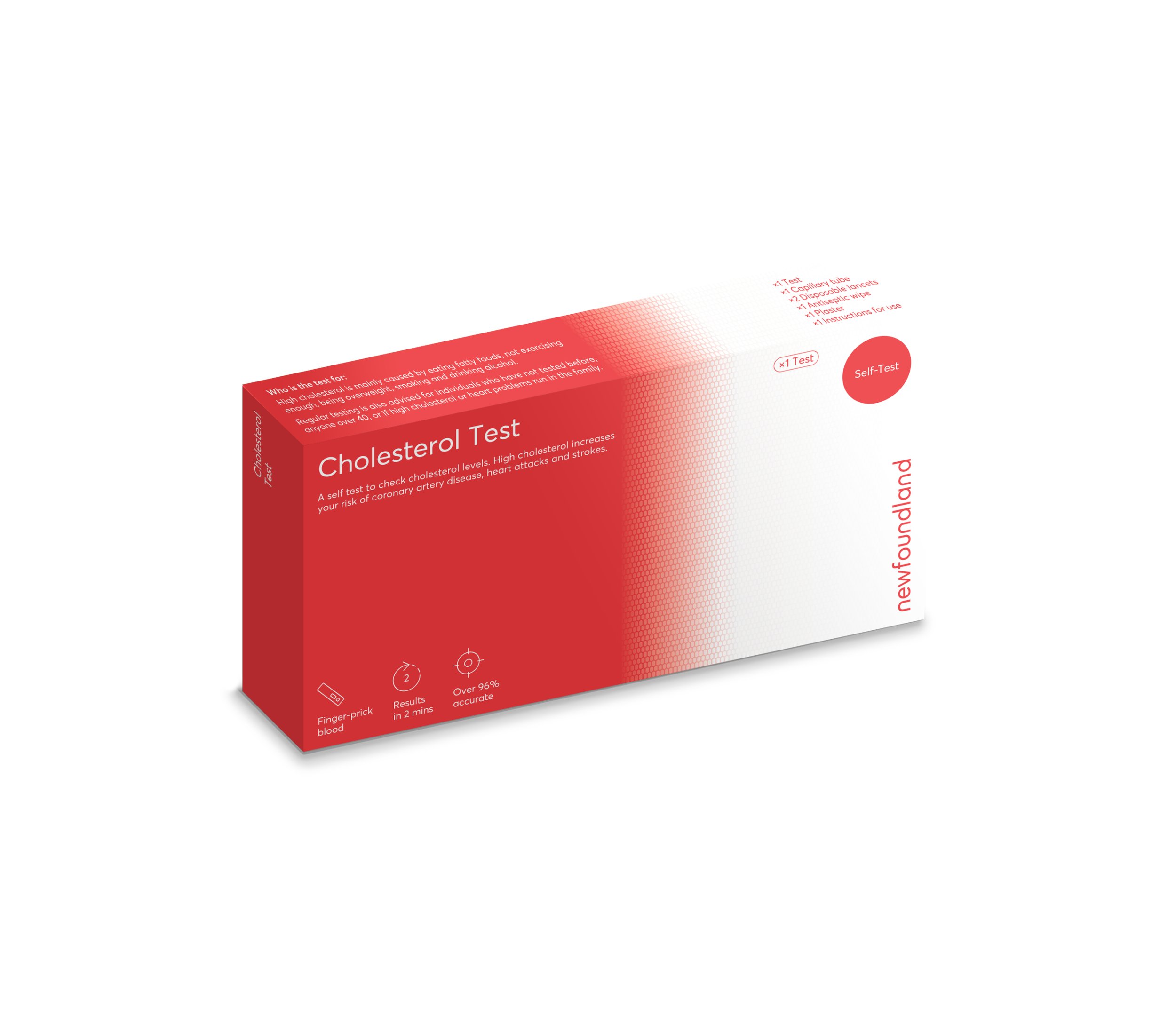Cholesterol
A self-test to identify cholesterol levels in finger-prick blood. High cholesterol increases your risk of coronary artery disease, heart attacks and strokes.
Accuracy
>96%
Certifications
CE self-test | MHRA
Specimen
Finger-prick blood
Self-test
-
According to the NHS, over half of UK adults are thought to have high cholesterol. This is when you have too much of a fatty substance called cholesterol in your blood. Too much cholesterol can block your blood vessels and lead to serious health conditions. High cholesterol is mainly caused by eating fatty foods, not exercising enough, being overweight, smoking and drinking too much alcohol, but it can also run in families.
The Newfoundland Cholesterol Test measures the level of total cholesterol in the blood and provides three medical risk groups: high, borderline high and desirable.
The NHS recommends that healthy adults should have a cholesterol reading of no more than 5mmol/L.
-
Preparation:
1. Wash your hands with warm water and soap, carefully drying your hands afterwards. Note: Use of lotions and hand creams should be avoided before testing.2. Open the foil pouch and remove the test kit. Note: Please ensure the test kit is facing the correct way up before testing.
Obtaining a blood sample:
3. Hold the lancet and twist the white cap to remove.
Note: Be careful when removing the cap of the lancet that you twist it off. If you pull it, then it might prematurely fire the lancet rendering it unusable. Similarly, if you snap the cap off without twisting it, then you might break off the stem of the cap, again making the lancet unusable.4. Use the antiseptic wipe provided to clean the finger that will be pricked with the lancet (the side of the ring finger is recommended). Massage your hand from the wrist to the fingertip to increase blood flow.
5. Place the lancet against the fingertip and press down firmly to draw blood. Replace the cap onto the used lancet and set aside.
6. Wipe away the first drop of blood with a clean tissue.
7. Collect the second drop of blood using the capillary tube to fill the line indicated. Apply the plaster to your finger if needed.
Note: Please check how to use the capillary tube first before using it.
Tips
1. Hold the capillary tube horizontally and slightly downward.
2. Without squeezing, touch the tip of the pipette to the blood.
3. Capillary action will automatically draw the blood sample. You may need to massage your finger again if more blood is required. Collect to the fill line and stop.
4. Do not squeeze or block the air vent during collection of the blood sample.
Performing the test:
8. Gently squeeze the dropper to apply the blood sample into the sample well and wait for 2 minutes before turning the test kit over. DO NOT turn over the test kit before 2 minutes.
Note: Squeeze the bulb until all the blood in the capillary tube is applied. If you don’t apply sufficient blood to the sample well, the result may be inaccurate. The sample well should be completely covered with blood. If the blood sample was smeared or too little blood was applied, you should dispose of the test kit and repeat the test with a new kit.9. Turn over the test kit after 2 minutes and slide the colour chart to find the closest colour match within 30 seconds. This is your result.
Note: The test result must be read within 2 minutes 30 seconds of applying the blood sample. Results may be inaccurate if read too early or too late. A test area that appears lighter than the 99mg/dL colour block should be interpreted as a cholesterol result of less than 99mg/dL (i.e. low cholesterol). A test area that appears darker than the 250mg/dL colour block should be interpreted as a cholesterol result greater than 250mg/dL (i.e. high cholesterol). -
Adults
<200 mg/dL(<5.18 mmol/L) : Desirable
200-239 mg/dL(5.18-6.19 mmol/L) : Borderline high
≥ 240(≥ 6.22 mmol/L) : High
Children
<170 mg/dL(<4.40 mmol/L) : Desirable
170-199 mg/dL(4.40-5.15 mmol/L) : Borderline high
≥ 200(≥ 5.18 mmol/L) : High





